The appearance of a new deck based on this Gatecrash card gives me a great opportunity to analyze the Evolve mechanic. As this keyword ability uses the “intervening ‘if’ clause” rule, let’s also talk about this kind of triggers.
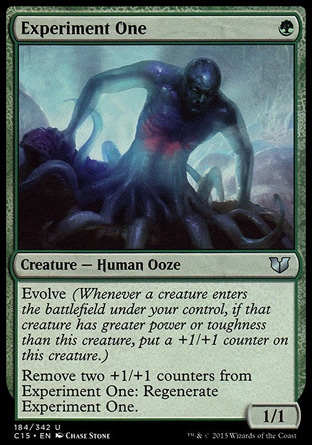
Oracle Text:
Creature — Human Ooze
Evolve (Whenever a creature enters the battlefield under your control, if that creature has greater power or toughness than this creature, put a +1/+1 counter on this creature.)
Remove two +1/+1 counters from Experiment One: Regenerate Experiment One.
Experiment One is a green creature (green mana symbol in its cost indicates this) with two subtypes: Human and Ooze. These are two different creature types, and each can create interactions between cards. For example,
- If you control Experiment One, your Angelic Overseer has hexproof and indestructible.
- You can sacrifice Experiment One to pay for Fiend of the Shadows’ third ability, but you can’t do so to activate the ability of Ooze Garden.
- When Angel of Glory’s Rise EtB-trigger is resolving, you will return Experiment One from your graveyard to the battlefield.
- When Experiment One enters the battlefield, Champion of the Parish’s ability triggers.
- As Cavern of Souls comes into play, (to cast our hero) you can name either “Human” or “Ooze”, but not “Human-Ooze”.
Experiment One has two abilities. The first one, Evolve, is a triggered ability. This is indicated by “Whenever” in its text. The second one, as defined by colon in its text, is an activated ability. You can’t activate it if your cunning opponent enchants Experiment One with One Thousand Lashes, although Evolve will still work normally.
Evolve
702.98a Evolve is a triggered ability. “Evolve” means “Whenever a creature enters the battlefield under your control, if that creature’s power is greater than this creature’s power and/or that creature’s toughness is greater than this creature’s toughness, put a +1/+1 counter on this creature.”
702.99b If a creature has multiple instances of evolve, each triggers separately.
Evolve is a conditional triggered ability, as indicated by the “intervening ‘if’”. Let’s read the text carefully (the relevant parts are colored).
Whenever’ is a triggered ability marker.
a creature enters the battlefield under your control’ is the trigger event. Its occurrence is necessary for the ability to trigger. However, in the “intervening ‘if’ clause” case it isn’t sufficient.
if’ that immediately follows a trigger event indicates that it’s an ability that uses the “intervening ‘if’ clause” rule. The word ‘if’ anywhere else in the text of the triggered ability has only its normal English meaning and the trigger functions as usual. For example, Extort, Azor’s Elocutors.
that creature’s power is greater than this creature’s power and/or that creature’s toughness is greater than this creature’s toughness’ is the trigger condition. For the “intervening ‘if’ clause” rule meeting the condition is as important as the trigger event itself. The ability checks whether the stated condition is true twice:
- When the trigger event happens — if the condition isn’t true, the ability doesn’t trigger.
- When the trigger resolves — if the condition isn’t true, the trigger doesn’t resolve and is removed from stack. There’s no effect.
put a +1/+1 counter on this creature’ is the trigger effect. There is an effect only if the trigger resolves.
Thus, Evolve of a creature you control, namely Experiment One, triggers if:
A creature comes into play under your control. It doesn’t matter how it will appear on the battlefield. It can be a creature spell resolving; an effect moving a creature to another zone (for instance, Sneak Attack or Restoration Angel); or tokens that are created (by Populate, for example). If a permanent that has already been on the battlefield for a while changes its characteristics, it doesn’t mean that it enters the battlefield! Transforming Mayor of Avabruck or animating Gruul Keyrune don’t trigger Evolve.
Power of the creature entering is greater than Experiment One’s and/or its toughness is greater than Experiment One’s. Note that you should only compare toughness with toughness and power with power. When defining the entering creature’s characteristics every effect modifying its P/T should be taken into account (including counters).

If you control a Mountain, your Flinthoof Boar enters the battlefield as a 3/3 creature.
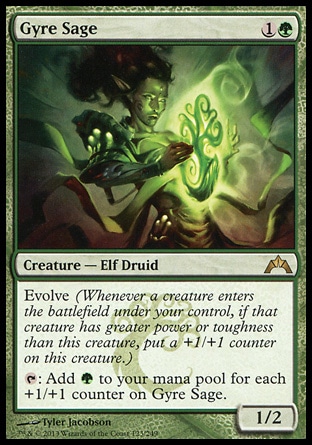
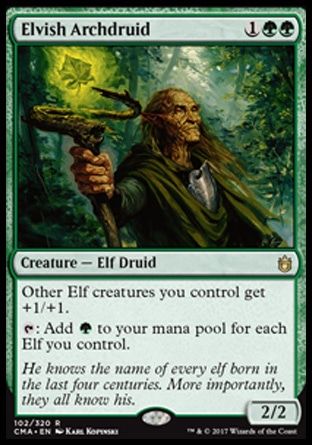
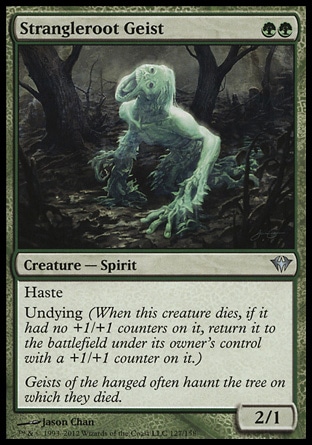
Strangleroot Geist enters the battlefield during the resolution of its Undying trigger. There’s no such moment when Strangleroot Geist is already on the battlefield but doesn’t have a counter on it. So unless something else happens Strangleroot Geist will enter the battlefield as a 3/2 creature. Experiment One’s Evolve will trigger if it has one or zero counters on it.

You shouldn’t mistake effects which say enters the battlefield with +1/+1 counters on it’ for EtB-triggers’ effects which put counters on the entering creature on resolution. When Umara Raptor comes into play, its ability triggers, but a +1/+1 counter will be put only when the trigger resolves. As Umara Raptor is 1/1 when it enters the battlefield, Experiment One’s Evolve doesn’t trigger.
Neither player can do anything to change P/T in order for Evolve to trigger (or to prevent it from triggering). You can’t play a creature and then pump it with Giant Growth so that another creature can evolve. The same goes for your opponent: if a creature big enough entered the battlefield under you control, nothing can prevent Evolve from triggering. However, you can affect the existence or resolution of the trigger:

Special spells can counter triggers, which includes Evolve.
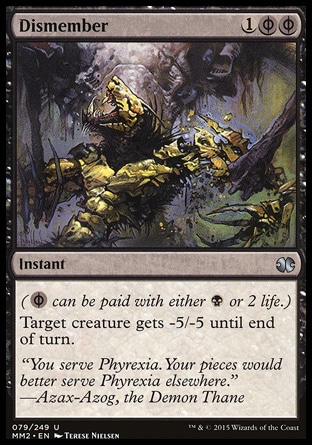
As the condition is checked on resolution, you can “shrink” the creature that has entered the battlefield so the trigger won’t resolve.
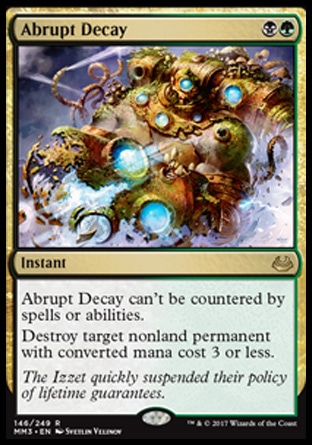
If a creature that has entered the battlefield is destroyed before Evolve resolves, Last Known Information is used.
If several creatures enter the battlefield simultaneously, Evolve can trigger several times. After SBA are performed, each player puts the trigger he or she controls on the stack in APNAP order. A player can choose in which order he or she is going to put his or her triggers on the stack. Each Evolve trigger is an independent object. It resolves when it’s a topmost object of the stack and both players pass in succession. The comparison of characteristics happens on resolution of each ability.

Assume you have Experiment One without counters. On Knight Watch’s resolution you get two 2/2 tokens. Evolve triggers twice. In this case it’s irrelevant in which order they are put on the stack. When the top one resolves, Experiment One gets +1/+1 counter and is a 2/2 creature. On resolution of the second one the condition isn’t met, so the trigger is removed from the stack.
If a creature with Evolve enters the battlefield at the same time another creature does, the ability triggers in case the condition is true:
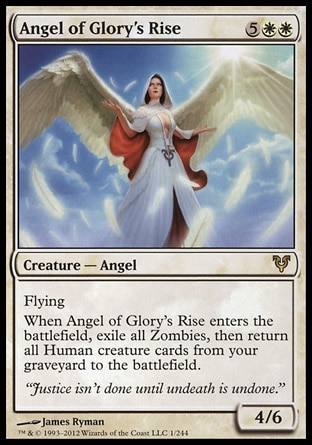

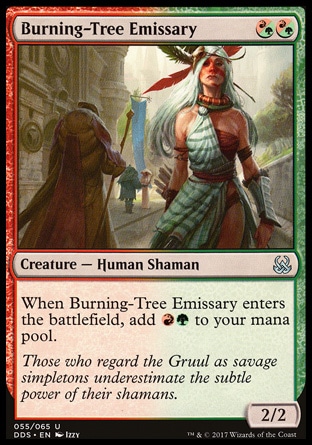
If on resolution of Angel of Glory’s Rise’s EtB-trigger you return Experiment One and Burning-Tree Emissary, Evolve will trigger due to rule 603.6a …Each time an event puts one or more permanents onto the battlefield, all permanents on the battlefield (including the newcomers) are checked for any enters-the-battlefield triggers that match the event.
It can happen so that the characteristic that was bigger when Evolve had triggered is smaller on trigger’s resolution and the second one that was smaller is now bigger. In this case the trigger will still resolve and put the counter on the creature with Evolve.
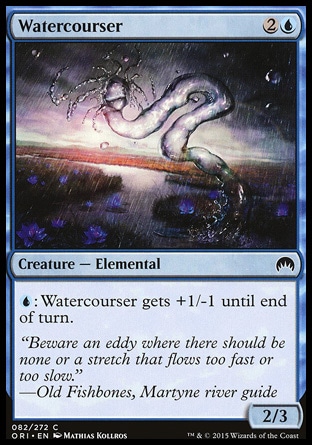
Suppose you control Experiment One with one +1/+1 counter on it. Watercourser enters the battlefield under your control. As its toughness is greater than Experiment One’s, Evolve will trigger. If you activate Watercourser’s ability in response to the trigger, it will become a 3/2 creature. On Evolve resolution Watercourser’s power will be greater than Experiment One’s, so the trigger will resolve and Experiment One will get a second +1/+1 counter.
And for dessert:
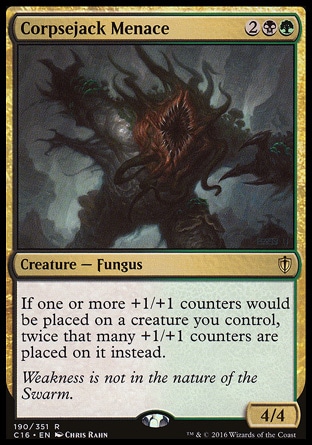


You control Corpsejack Menace, Master Biomancer and Experiment One with three +1/+1 counters on it. A 1/1 token comes into play. What happens?
Renegade Krasis from Dragon’s Maze introduced the term “evolves” that is defined as getting +1/+1 counters as Evolve trigger resolves.
It is time to come back to Experiment One’s second ability. Let’s color it the same way we did with Evolve: “Remove two +1/+1 counters from Experiment One : Regenerate Experiment One.”
- : (a colon) is a marker of an activated ability. Activated ability is always defined by a colon.
- Remove two +1/+1 counters from Experiment One — is the ability activation cost. The cost is paid during activation (after the ability is put on the stack).
- Regenerate Experiment One — is the ability’s effect. It is applied only if the ability resolves.
There are no restrictions on this ability’s activation. You can activate it any time you have priority and there’re at least two +1/+1 counters on Experiment One you can remove to pay the activation cost. It doesn’t matter how long Experiment One has been on the battlefield under your control. It also doesn’t matter if the ability was activated earlier. It’s just the same whether there is going to be an event that can be replaced by regeneration or not.
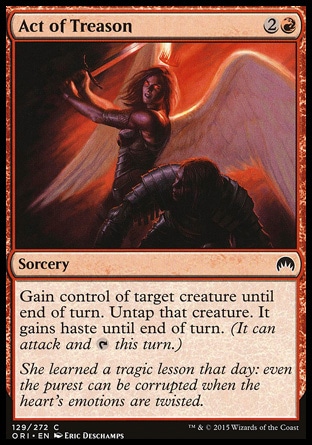
If you control opponent’s Experiment One due to the effect of Act of Treason, it’s a great idea to activate the regeneration ability. The creature will be much smaller when it returns to its owner, and the regeneration shield will cease to exist on cleanup step.
Moreover, activation of this ability can kill Experiment One. Just as with Golgari Grave-Troll, when you activate the ability it modifies the creature’s toughness. If Experiment One with two counters has at least one damage marked on it, the ability activation will lead to creature’s death. The next time SBA are performed it will be put into graveyard (as a creature that has been dealt lethal damage). At this moment the ability hasn’t yet resolved and, consequently, cannot save Experiment One. Convenient indeed!
As the Experiment One’s ability resolves, a regeneration shield is created which doesn’t affect the card in any visible way: Experiment One doesn’t tap when the ability resolves!
- ⇑ Flinthoof Boar’s ability that enhances its characteristics is static and works only on the battlefield. In any other zone Flinthoof Boar is 2/2 no matter whether if you control a Mountain or not (it’s not a characteristic-defining ability).
- ⇑ If a creature leaves battlefield because it was “shrinked” and its toughness became zero or less, the characteristics used as LKI will be those after “shrinking”.
Translated by Bella Dasaeva

If you control Gyre Sage without counters and an Elvish Archdruid comes into play under your control, then Gyre Sage is immediately affected by Elvish Archdruid’s static ability and is 2/3; therefore Evolve doesn’t trigger.